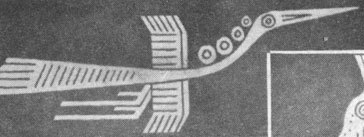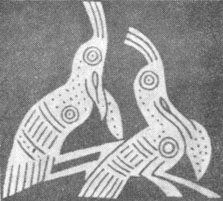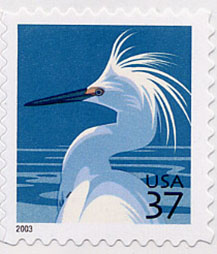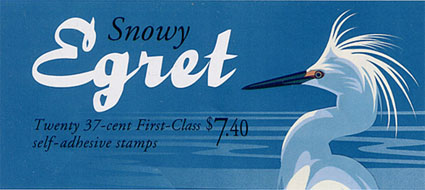What Kind of Bird On The Ancient Drum?
If the word "Lac" is interpreted as a bird, and "law, lawah, loh" mean rice, "Lac farms" means rice fields and "Lac Viet" is the Viet people who survived with growing rice, then a new question should be posed: what kind of birds is engraved on the ancient drums?
Prior to answering this question, we should ask an additional question: in Vietnam, what birds live in rice paddies, closest to farmers and farming? The answer to this question probably helps answer the other question, namely about the bird image engraved on the ancient Lac Viet drums, which are the drums of the Viet people who grew rice in their "Lac farms".
In the rice paddies in Vietnam, one often see the following birds: sparrows, "sugar cane" birds (living on sugar cane trees), flower peckers, mynahs, cuckoos, storks, cranes ... Storks and cranes are the two birds that match the image of the bird on the ancient drums better than the others, with long bills, long necks, and large wings.
In addition to the bird images, there are many more man-like figures on the drums; perhaps they represent dancers, or dancing soldiers. These men decorate themselves with long bird feathers on the heads. Among the birds in the rice paddies in Vietnam, storks have long feathers which can be used to decorate head wears, just like in the images on the Lac Viet drums.
Below is a figure of a bird that is redrawn from the image engraved on Ngọc Lũ drum, which is quite similar to the image of "cruising stork" in Vietnamese proverbs, which can be seen now and then in rice paddies in Vietnam.(19)

On the Lac Viet drums, one can also see images of birds standing on tree branches, as shown in the figure below.(19)

One can now pose two questions:
1. What is it that is seen in the neck area of these birds? Three possible answers: i) it could be a bursa. If so, can these birds be pelicans? Pelicans do exist in Vietnam; however, storks outnumber pelicans. Storks can be seen everywhere, near ponds or rice fields, in the plains or on the plateaus, from the North to the South; pelicans are rarely seen in some areas in Vietnam. ii) perhaps, the image shows a stork resting on a tree branch with a prey in its mouth. iii) perhaps, it is a stork’s feather blown backwards.
2. Why the long "mane hair" on the bird’s head?
They are not really "mane hair". If you live in rural areas in Vietnam, you may witness what you see in the image. On windy days, stork’s feather is blown up to make it look like "mane hair".
Perhaps in the old days, people liked to decorate with bird feathers and they drew stork feathers in their art pieces. Is it the long hair on stork’s head so unique and appealing that the United States Post Office chose such image on one of their stamps issued in 2003? This stork is the "snowy egret", one kind of storks that live between the southern United States and Chile/Argentina. Their long, beautiful snowy white feather attracts hunters for their hair for decorative pieces. At present, the U.S. government bans hunting this kind of storks to protect them from extinction.


The above figure is on envelopes that contain twenty 37-cent postage stamps featuring Snowy Egret.
Storks show up everywhere in Vietnam, in the plains and on the plateaus. Storks like to catch fish, shrimps, crabs and frogs in ponds, rivers and especially rice fields. Storks are associated with agricultural life, as they are often found in Vietnamese proverbs and folk songs. Storks have long legs walking through the fields and dip their long bills into muddy water to search for their preys, the muddier the water, the more preys. Sometimes they trample on rice plants and damage them! Hence this folk song
Oh, storks, storks, storks!
Why did you guys trample on my rice plants?
No, Sir, not me, I am standing on the shore
The other storks blame me for what they did
Whenever going to the fields, farmers often encounter storks, in early morning, late afternoon, or even at night:
A stork goes for night hunting,
Standing on a soft tree branch, and falling onto the pond...
On beautiful sunny days, storks joyfully dance in the sky as can be pictured from the following folk song:
Storks are flying and dancing
Over the rice field, over the green field...
Their slender body, their laboriousness and their hard working bring to mind the image of Vietnamese women who work laboriously in the field to get foods for their family, so that their husbands can do their duties:
Like a stork working along river banks,
Crying on farewell to her husband.
She stays behind to raise their children,
So that husband can do his duty in Cao Bang...
This folk song brings up the same image of typical Vietnamese women in a famous poem by Trần Tế Xương praising his wife:
Buying, selling all year round along the river banks
To raise five children and one husband
Walking like a stork through the muddy river when no boats are around
Can’t stop to catch a breath when boats arrive
Fate or duty, what’s the difference?
Sunny hot or rainy cold, just no difference
It’s simply a pity, truly a pity;
Being married, but absolutely no helps from husband!.(20)
All the above folk songs, proverbs and poems show that storks are very close to the Vietnamese in general and the Vietnamese farmers in particular. So, in the dawn of the Vietnamese history, storks must have been also close to the Lac Vietnamese while cultivating their farms, which according to Giao Châu ngoại vực ký were rice fields. Rice fields are the environment suitable for storks.
In the ancient days, farmers saw storks feeding in rice fields, and the image of storks was imprinted in their minds and their feelings. Therefore, possibly, the Lac Viet people engraved the image of storks on their drums. In other words, the birds on the Lac Viet drums may be the storks in ancient Vietnamese rice fields, and this stork species still persists in Vietnam nowadays.
When explaining the word "Lac Viet" and the bird image on the Lac Viet drums, the researchers such as Đào Duy Anh and Nguyễn Phương only focused on the classical Chinese dictionaries, they did not pay attention to the Vietnamese dictionaries such as Annamiticum-Lusitanum, et Latinum , Đại Nam quấc âm tự vị, or Từ điển tiếng Việt , all of which were all available for their references.
In addition, there is a huge dictionary that anyone can look up, which is the life of Vietnamese farmers in natural environment, surrounded by plants and living creatures. It is those rice fields across the country, with live animals relying on the fields for their survival.
In fact, these fields have fed our people from the dawn of our history; they also have fed birds and animals, including storks. These birds have lived closely with farmers, but scholars and researchers did not notice them simply because they are too common, too popular.
Stork is the subject in folk songs, proverbs, poetry, and music; why can it not be the subject in sculpture and painting? The images on the Lac Viet ancient drums are part of the very old sculpture and painting that were made over 2,000 years ago.
In conclusion, let’s note again that all the images on the Lac Viet drums are "unspeakable" images. All discussions about the images on Vietnamese ancient drums, including this article, are just conjectures, speculations, not conclusions. Hypothesis may be true and it may also be wrong; but a reasonable hypothesis has more chances to survive. Hopefully there will be more discussions on this issue to shed more lights to the history of ancient Vietnamese.
(Toronto, Canada)






